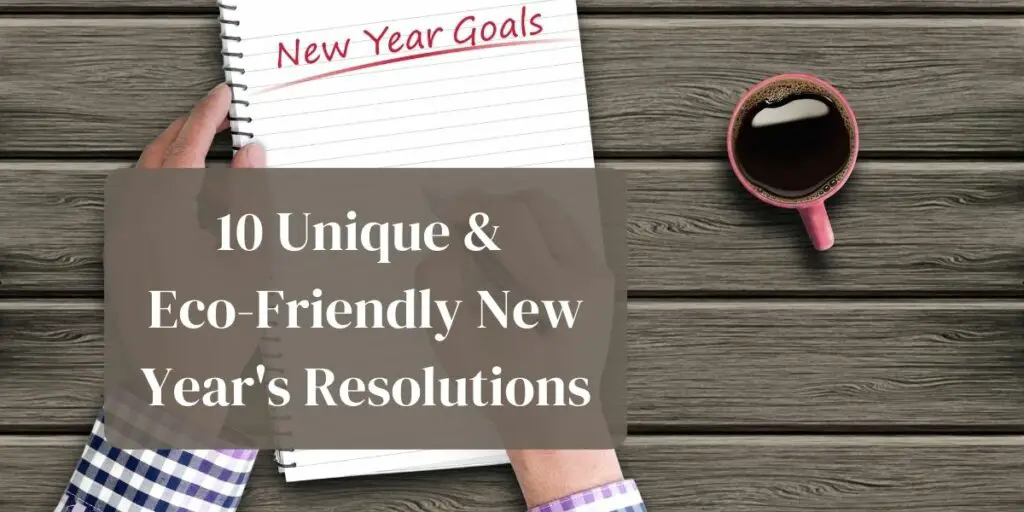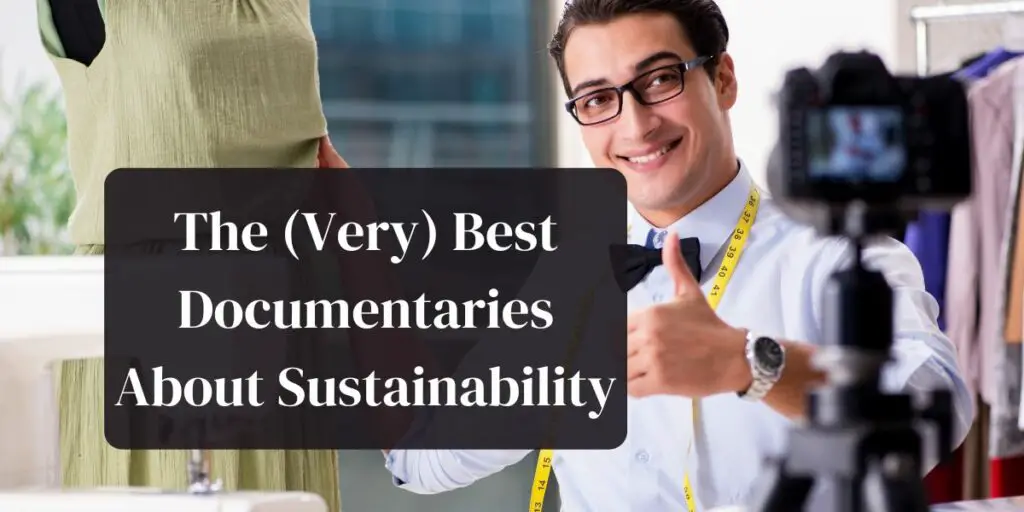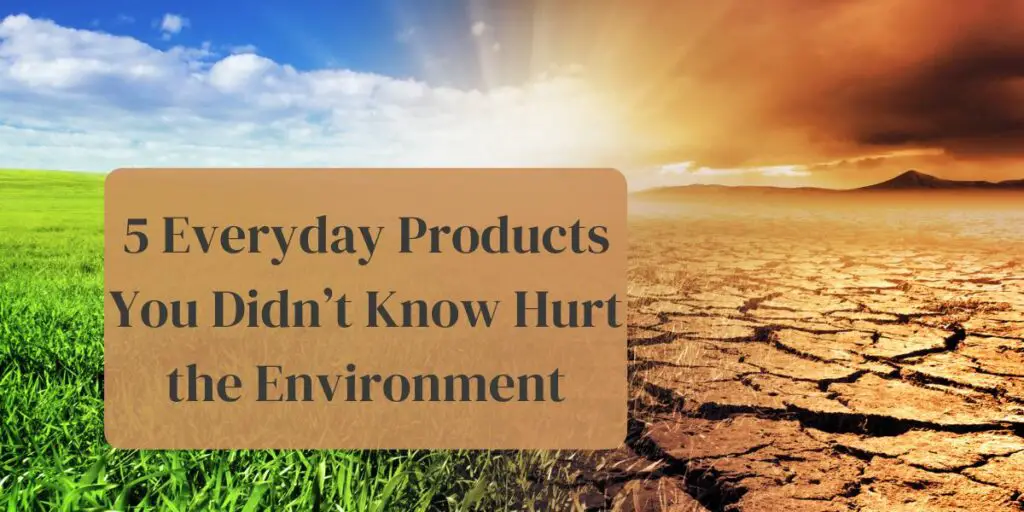Going into a new year does always give me this special feeling. The most common question to ask yourself is: “Did I make the best of the year that has past? Did I learn as much as I hoped?”.
Instead of looking backward, I decided to ask myself this January:
“What can I do to make sure that my lifestyle is more eco-friendly this year compared to what it was last year?”.
Based on that thought, I wrote down 10 unique and smart new year’s resolutions. PS! Feel free to use them – there is no copyright on these! 🙂
Most of these “new year resolution” lists are very general and broad. However, I will provide you examples on every single one of them to make this article relevant and crystal clear.

Table of Contents
- In a hurry? Here’s a short version of the full list
- #1: Reduce my meat consumption – is it really possible?
- #2: Uber over taxi any day
- #3: Keep uploading content about the environment online – and keep talking to people about climate change!
- #4: Reduce my bread waste
- #5: Change my travel habits to reduce my CO2 emissions
- #6: Skype > Foreign business trips
- #7: Christmas or birthday party? I will not buy any unnecessary products!
- #8: Shop local food
- Meat is not the only food that is harmful to the environment. A great example of a fruit that causes a lot of CO2 emissions is the avocado. I stopped eating them for several reasons.
- #9:….or even better, make my own food in my backyard!
- #10: Stop shopping for Q1 and Q2
- Final thoughts – are you going to make some changes to your life?
In a hurry? Here’s a short version of the full list
1. Eat less meat
2. Take a part in the sharing economy (Uber, AirBNB, Wework, etc.)
3. Keep educating people about the environment without being annoying
4. Reduce my bread waste by 50 %
5. Use the train instead of airplanes (Ecotourism)
6. Replace business trips with Skype conference calls
7. Give experiences instead of products as gifts
8. Buy local food
9. Improve my vegetable garden
10. Will not buy any clothes until the summer (“shop stopping”)
Curious? Want to read more? Great! 🙂
Keep reading on…I bet you will learn something useful from this article.
#1: Reduce my meat consumption – is it really possible?
Reducing my meat consumption is something that I have been working on for quite a while. It took me several Netflix documentaries to understand how big of a problem the meat industry is.
Instead of going on about my own “meat-free journey”, I will lead you to one of the better articles that I have ever written.
If you want to read more about my meat-free journey, feel free to read this article. I explain in detail everything you have to do to reduce your meat consumption without reducing your life quality. To be honest; I did not think I could do it…until I started. 🙂
How bad is meat for the environment?
Very bad.
According to the UN’s Intergovernmental Panel on Climate Change, agriculture, forestry, and other land use accounts for 24% of greenhouse gases. (Source: The Guardian). In addition to that, there is a huge ethical discussion going on whether or not it`s “nice” of humans to eat animals.
#2: Uber over taxi any day
I do not take taxis anymore. If I want to use an external car for transportation, I always use the “shared seating” option on Uber. Comfortable…and it sometimes leads to nice conversations in the backseat. 🙂
What else can you do in regards to day-to-day transportation?
Buy an electric car. Or sell your old car and start to use public transportation.
My parents recently bought Ioniq, which is super comfortable to drive. I know that it might be a bit of a hassle to only be able to drive 160 kilometers before you have to charge, but that is something you get used to. If you live in the countryside, I understand that you might be dependent on your car.
However, some cars pollute less than others. Please be aware of the total CO2 emissions when you purchase a car. That will save you money (less gas) and also help the environment.
#3: Keep uploading content about the environment online – and keep talking to people about climate change!
This website is a great platform for me to educate people. When I write this blog post, Sustainability Matters has an average of 100 people coming into the website every day. That is great!
I do often tend to involve myself in some discussions with people I know about the environment. So many people have misconceptions about global warming, which makes it hard to not join these discussions. In general, I hate to listen to factually wrong people.
Best tips to succeed with “preaching” an eco-friendly message
Start a website. Or sign up in some discussion forum online where environmental topics are being discussed.
If you are knowledgable about a topic, I would also say that you should talk to friends, classmates, and colleagues about climate change. What I find interesting is the total lack of knowledge that some people have about this topic. The best thing would be to identify and educate those who haven`t understood the importance of stopping global warming.
#4: Reduce my bread waste
I already wrote a quite long article about bread waste. It is called “10 innovative ways to reduce bread waste at home“, and I think you will find it very fascinating.
Implementing all of these practices mentioned in the article, helped me reduce bread waste with 70-90 %. Frankly, that is just the beginning. It might sound like a lot (and it is), but I am not giving up until I reach my new ambitious goal:
My goal this year is to hit zero. Not a single slice of bread should be thrown in the garbage. 🙂
#5: Change my travel habits to reduce my CO2 emissions
Most of my friends do not even think of the train as an option when they go abroad. Living in Norway, we are quite far away from all the “fun” holiday destinations.
I am not going to go on a rant, but let`s be honest: the government is not doing it easy for people who want to travel without large CO2 emissions. A couple of minutes ago, I ran a quick check to see the prices on a one-way ticket from Oslo to Berlin:
Train: 173 – 321 $ USD
Screenshot:

Flight: 41 – 73 $ USD
Screenshot:

Ouch…as you can see, the prices on flights are super cheap. In addition to saving money, you also save about 12 hours of travel. I am not surprised that people keep flying more and more.
Example of how to travel more eco-friendly: European Championship in Football 2020
During the upcoming summer, I am going to München to watch Germany play against Portugal. Instead of flying back and forth to München for an extended weekend, I chose this path:
1. Train from Oslo to Copenhagen, where I stay for three nights with some friends.
2. Train from Copenhagen to Berlin. This is where I meet my friends.
3. After the game finished, I am flying home.
It doesn`t take much to be a bit flexible on your holiday. However, I do understand that it is impossible to go by train if you are going from Los Angeles to Bangkok. On the other hand, it might be a good idea to limit the number of long-distance flights per year?
#6: Skype > Foreign business trips
“Hey, we would like to invite you to a meeting in Stockholm next month – are you guys available?”
The e-mail was sent to me and some of my colleagues. After talking to my boss, we decided to ask whether or not they had an agenda for our visit. It turned out that they just wanted to “catch up and discuss opportunities for the new year“.
Did I hear that right? A flight to Stockholm just to “catch up”?
Sorry, mate…that can be done through a conference call on Skype. It would save us money, time and CO2 emissions. So we did – and we had a great meeting.
This is just one of many examples throughout my career as a digital marketing guy. An article published on Raconteur.com showed that about 50 % of most company’s CO2 emissions can be traced back to business travel.
It might feel uncomfortable to question your boss about travel habits within the company, but this is a point where a lot of companies have a huge potential for improvement.
#7: Christmas or birthday party? I will not buy any unnecessary products!
Unless someone is very specific about what they wish to get, I will give them an experience instead of a physical product. There are three reasons for that:
1) I have no idea what to buy people when they say “surprise me” or do not give specific instructions. Often I end up buying some crap.
2) People tend to be happier when receiving
3) You do not fill up someone’s bedroom with something they don’t want, which will help the environment.
What type of “gift experiences” do I talk about?
Bungee jumping, a trip to Hawaii, a day at a racing car track, tickets to Disneyland, tickets to a Taylor Swift concert, fishing experiences, etc.
There are so many companies that are focusing on these experiences, which makes it quite easy to find them regardless of where you live. I did a lot of research and figured out the ones with the best reviews in the US:
– Cloud9living ( https://www.cloud9living.com/ )
– Tinggly, which operates worldwide ( https://www.tinggly.com/ )
– Xperiencedays ( https://www.xperiencedays.com )
#8: Shop local food
Meat is not the only food that is harmful to the environment. A great example of a fruit that causes a lot of CO2 emissions is the avocado. I stopped eating them for several reasons.
causes a lot of CO2 emissions is the avocado. I stopped eating them for several reasons.
– the avocado production in South America is driven by criminal gangs. If you don`t believe me, feel free to read this article.
– the avocados are flown from Chile to Norway.
– In Norway, they are packed into a lot of plastic and sold for a huge price.
Nah….no more avocados on me.
Sourcing local food is NOT difficult in most countries
I would urge people to look into what type of local food they can get their hands on. Most supermarkets have a section for local food, and farmers are also very good at branding themselves as “local” if their farm is located nearby.
#9:….or even better, make my own food in my backyard!
I have previously written an article about this topic as well. My vegetable garden is not very impressive, but it provides me with quite a lot of apples, potatoes and various vegetables every year.
My goal this year is to not only improve the current set-up but also to expand into other vegetables. 🙂 Warmer summers due to climate change has one, and only one, benefit: it is easier to grow your vegetables in Norway.
#10: Stop shopping for Q1 and Q2
Until June, I will not buy any clothes at all. Unless I lose something (my scarf on the bus) or is in desperate need of something (football shoes if they get broken), I will not enter any clothing shop at all. That saves me money – and it makes me appreciate the clothes that I already have.
Final thoughts – are you going to make some changes to your life?
I`m just gonna be straight up honest. 95 % of you will read this article without making any improvements. Please don`t be that person.
4 % of you will have this article in mind when you buy a new diesel car, booking a ticket to Thailand or throw an avocado party.
However, I would like to focus on the 1 % that will do some proper change in your life. New Year`s resolutions should not be forgotten in mid-January. Unless you do change your life to become an environmentalist, there is no point in reading articles like this. It might sound a bit harsh, but I am just telling you the truth.
We need to see a positive change in the world – and you are very much welcome to be a part of that.
PS! Feel free to comment below if you pledge to any of these eco-friendly new year`s eve resolutions! 🙂



Great list of action points. I really agree with the Skype/business trip thing. Unless you had a job that would require a lot of traveling, you do not understand the hassle of flying around trying to get to some meetings where you literally could participate by having Skype installed on your phone.
I am serious. Most of the meetings with clients where you meet them face-to-face have been really unnecessary and waste of time for me and them.
Businesses need to understand that they do not only save the environment (because most of them dont care), but also money.